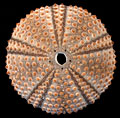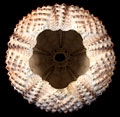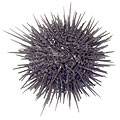|
Diagnostic Features
|
- Test flattened below, gently domed above.
- Apical disc small; dicyclic; plates firmly bound to corona. Ocular pores double. Periproct oblique, covered by four large plates forming an anal valve. No tubercles on apical disc plates, but distinct epistromal ornament.
- Ambulacra more or less straight; plating trigeminate throughout; pore-pairs uniserial aborally with suckerless tube-feet, the pore-pairs elongate and conjugate. Pore-pairs expanded into a strong phyllodes adorally, with rounded pore-pairs and strong, suckered tube feet.
- Plate compounding arbaciid-style with the upper and lower elements reduced to demiplates. More complex plating adorally. A single primary tubercle to each compound plate.
- Interambulacral plates wide; with 2-5 subequal primary tubercles forming a horizontal row on each plate. A few small granules only around edges.
- Primary tubercles imperforate and non-crenulate, with relatively large mamelon and poorly defined platform. Arranged in an en-chevron pattern.
- Peristome subpentagonal and very large (more than half test diameter), crenulated, with broad shallow buccal notches and a perradial notch. Smooth tags extend adradially from the buccal notches along the proximal interambulacral plates.
- Basicoronal interambulacral plate present at peristomial edge.
- Peristomial membrane rather naked, except for 10 buccal plates.
- Perignathic girdle with tall and slender auricles, generally fused perradially.
- Primary spines moderately long (usually a little less than the test diameter); ambital and adapical spines distally pointed, without cortex. oral spines ending in a small cap of glassy stereom (cortex).
- A single sphaeridium situated perradially close to the peristome in a pit.
|
|
Distribution
|
Miocene to Recent, Europe, North Africa, North & South America; Recent, Atlantic, Caribbean, West Pacific |
| Name gender |
feminine |
| Type |
Cidaris pustulosa Leske, 1778, p. 150 [=Echinus lixula Linnaeus, 1758, p. 664], by subsequent designation of Agassiz & Clark, 1908, p. 67. |
| Species Included |
- A. lixula (Linnaeus, 1758); Pliocene to Recent, Mediterranean and East Atlantic coastline and Brazil.
- A. dufresnii (Blainville, 1825); Recent, South America, Falkland Islands, sub-Antarctic region.
- A. punctulata (Lamarck, 1816); Pliocene to Recent, Eastern USA seaboard, Caribbean.
- A. spatuligera (Valenciennes, 1846); Recent, west coast of South America.
- A. stellata (Blainville, 1825); Recent, west coast of central America, Galapagos Islands. [includes A. incisa]
- A. crassispina Mortensen, 1910; Recent ,Tristan de Cunha.
- A. waccamaw Cooke, 1941; Late Miocene, eastern USA.
- A. rivula Cooke, 1941; Late Miocene, eastern USA.
- A. improcera (Conrad, 1843); Late Miocene, eastern USA.
- A. sloani (Clark, 1915); Late Miocene, eastern USA.
|
| Classification and/or Status |
Euechinoidea, Echinacea, Arbacioida, Arbaciidae.
Presumed monophyletic.
|
| Remarks |
Agarites has generally been treated as a synonym of Arbacia, differing only in having a naked interradial zone aborally.
Arbacia personata Lambert [Miocene, Cagliari, Sardinia] is not an Arbacia.
Gray, J. E. 1835. On the genera distinguishable in Echinus. Proceedings of the Zoological Society of London 3, 57-60.
Mortensen, T. 1935. A monograph of the Echinoidea II. Bothriocidaroida, Melonechinoida, Lepidocentroida and Stirodonta. C. A. Reitzel, Copenhagen.
|





